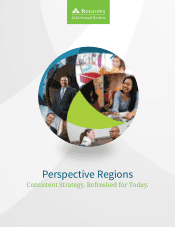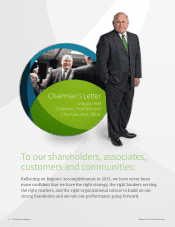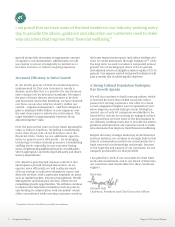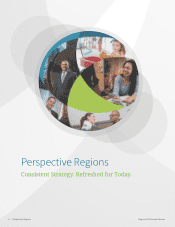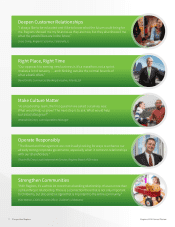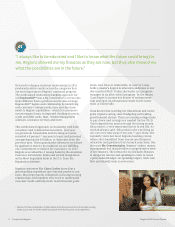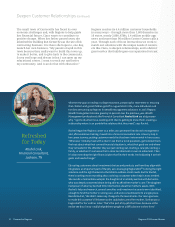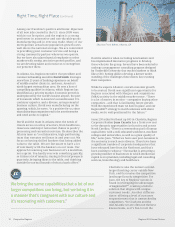Regions Bank 2015 Annual Report Download - page 4
Download and view the complete annual report
Please find page 4 of the 2015 Regions Bank annual report below. You can navigate through the pages in the report by either clicking on the pages listed below, or by using the keyword search tool below to find specific information within the annual report.
Guided by Five
Strategic Priorities
Our work to sustainably grow Regions’ franchise
is guided by a comprehensive strategic plan
that encompasses customers, associates, risk
management and nancial performance.
FOCUS
ON THE
CUSTOMER
BUILD
THE
BEST TEAM
MANAGE PERFORMANCE
STRENGTHEN
FINANCIAL
PERFORMANCE
ENHANCE
RISK
MANAGEMENT
(1)
Current year ratio is estimated.
(2)
Represents fully phased-in pro-forma ratio. Regions’ prior year
regulatory capital ratios have not been revised to reect the
retrospective application of new accounting guidance related to
investments in qualied aordable housing projects.
(3)
Adjusted for the reclassication of $834 million of certain leases
out of loans into other earning assets at year-end. For further
detail see page 19 in the fourth quarter 2015 supplement.
(4)
See table 2 in Form 10-K for GAAP to non-GAAP reconciliations.
Common Equity
Tier 1
(1),(2),(4)
Two-Year
bps Increase
10
2013 2014 2015
10.6%
11.0%
10.7%
Payout Ratio
Two-Year
Increase
2x+
2013 2014 2015
45%
46%
93%
Lower Total
Funding Costs
Two-Year bps
Improvement
12
2013 2014 2015
38 bps
31 bps
26 bps
Regions 2015 Annual Review4 Perspective Regions
improving, there are clearly significant pressures from the
global economy.
The fundamentals of our business were positive across the
board: We grew loans, checking accounts, deposits, customers,
households and credit cards. Growth in these categories enabled
us to reach our goal of increasing total revenue. For the year,
net income available to common shareholders totaled $1 billion
and diluted earnings per common share from continuing opera-
tions were $0.76.
As of year-end, Regions achieved total loan growth of 6 percent(3),
driven by our needs-based relationship banking approach.
Commercial and industrial loans were strong contributors
to expanded lending, which comprises 44 percent of our total
loan portfolio. Our business model that pairs local bankers with
industry specialists contributed to growth throughout our spe-
cialized industries group. Within our consumer lending port-
folio loan growth was broad-based, with increases recorded
in every category. Notable contributors were indirect auto
lending, with loan balances totaling $4 billion at year-end. In
2015 we also realized a healthy 4 percent(4) growth in adjusted
non-interest income, with strong contributions from Wealth
Management, card and ATM fees, and capital markets services.
A prudent risk management discipline is one of our foremost
responsibilities, and in 2015 our asset quality metrics remained
sound. Non-accrual loans as a percentage of overall loans
were 0.96 percent at year-end. Additionally, net charge-offs
declined 22 percent and represented 0.30 percent of average
loans. Overall economic trends across our markets were
generally positive in 2015. However, Texas and the Gulf Coast
experienced some pressure in a number of commodity-based
sectors, particularly the oil and gas industry. Persistently
low commodity prices have negatively impacted many of
the energy businesses we serve. We are staying close to these
customers as they take appropriate actions to lower costs and
reduce debt, and will continue to manage through these situa-
tions as constructively as possible.
Turning to capital deployment strategy, in addition to fund-
ing organic growth and strategic investments, an important
priority is returning value to shareholders. In 2015 we returned
$927 million to our owners in the form of quarterly dividends
and common share repurchases representing 93 percent of net
income available to common shareholders. Going forward we
will continue to deploy our capital effectively through organic

